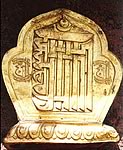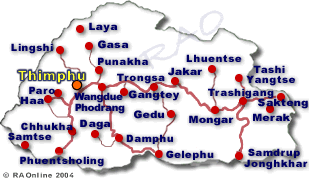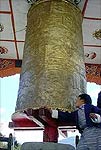 |
 |
Bhutan
Dzongs |
|
 |
Bhutan
Dzongs |
|
|
|
 |
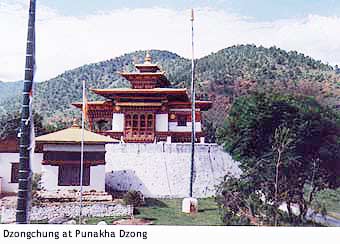 |
| Bhutanese
Dzongs have an unusual architectural magnificence about them. Architectural
grandeur is expressed in height and massiveness of a Dzong. Thus Simtokha
rises 4-storeys high, Tongsa high with wood and stonefacades 6-storeys,
and the principal capital citadel Utse (Central Tower) at Punakha is 80ft.
high. Most of theDzongs are the gigantic in structure, and rise high in
a pastoral landscape as impregnable fortresses set in a patternof architectural
design distinctively Bhutanese. Both in form and design the concept of
Dzong architecture is oneof the most elegant and harmonious in fortress
building in the world. |
|
Though
massive, the Bhutanese Dzongarchitecture is not heavy; it has both form
and elegance, and a rare blending of harmony and proportion. Although Dzong
system came to Bhutan from Tibet, and Lam Gyalwa Lhanangpa is credited
to have introduced it intoBhutan in the 12th century, yet the system transformed
itself into its dual functional role, soon afterwards and to adopt itself
to Bhutan's national and socio-economic requirements. Thus the earlier
Dzongs constructed by various saints, who came to Bhutan before Zhabdrung
Ngawang Namgyal, soon became archaic and incommodious for the temporal
and religious requirements.
Zhabdrung Ngawang Namgyal gave to the Dzong
system a larger dimension, and a new ideology. He built almost all the
principal Dzongs in Bhutan - Simtokha, Tongsa, Punakha, Wangdiphodrang,
Gasa, Tashichhodzong, and the Rinpung Dzong at Paro. The basic concept
of building these massive strongholds was primarily a bulwark or achain
of defensive fastnesses to check Tibetan inroads into Bhutan.
That the
system enlarged itself into a focal point of all Bhutanese national activities-social,
military, administrative and monastic, was a simultaneousdevelopment. Simtokha
was built to stop further Tibetan intrusions; Tongsa commanded the trail
between the eastern and western passes; Tashigang dominated the eastern
region; Punakha became a historical capital after Bhutan's victory over
the Mongol and Tibetan armies; Wangdiphodrang arose high between the rivers
PunatshangChhu and Dang Chhu as a sentinal; Tashichhodzong grew to become
the seat of central government; and finally, the Drukgyal Dzong guarded
the traditional route to Tibet.
| The
growth of these strategically located fortresses in Bhutan into defensive
and functional strongholds had adistinct set pattern. They are all massive,
gigantic and possess grandeur. Mostly located on a mountain spur, a Bhutanese
Dzong usually overlooks and commands the valley, rising steep on three
sides. Situated at the top of hillside are its watchtowers and observation
posts. The Dzong walls are made of mixture of sand and clay bricks, the
foundation is stone, and wooden beams are skillfully cut to fit each other
most dexterously. The traditional Bhutanese architecture has no nails and
no iron bars are used. Its foundation generally does not decline with the
slope of the rock; its high walls are thick and solid. |
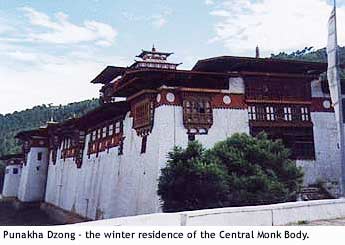 |
It
is usually oblong in construction, with a rectangular buildingsurrounding
a hollow square, in the centre of which is a larger tower several storeys
high, surmounted by a large copper cupola. The entrance to the Dzong, usually
by the side of the river, is over a bridge and single gateway linedwith
iron plates. Some of the Dzongs, as for instance, Rinpung Dzong at Paro
had an underground alley for exit intime of siege. A covered passage leads,
as in Jakar Dzong, to the source of water supply. As defence fortress a
Dzong's architectural design tends to make it not only impregnable and
inaccessible, but also quite harmonious with the landscape.
On the functional
side, as it served both as religious and administrative centre of the region,
it enlarged itself to accommodate both the monastic orders and administrative
officials. It has numerous outer and inner buildings for that purpose and
many temples. It serves the double purpose of a centre of religion and
also of administration. It is the focal point of all social, religious
and political activities of the region. The Dzongs contain some of the
finest statues of the Buddha and the Bodhisattavas. The meditative Buddha
Virochana with his female companion of Shakti is one of the most popular
themes of Bhutanese Sculptur.
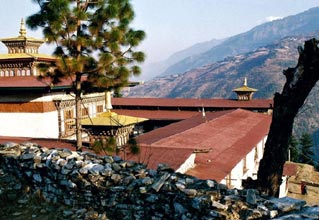
|
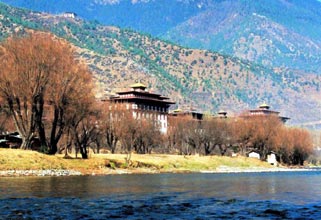
|
| Mongar
Dzong |
Tashichhoedzong
Thimphu |
|





